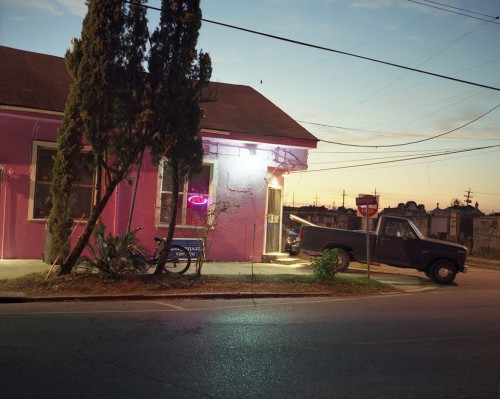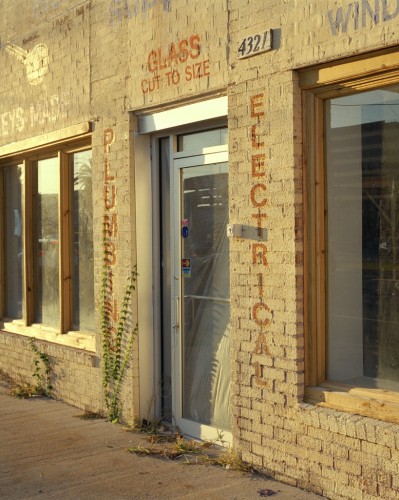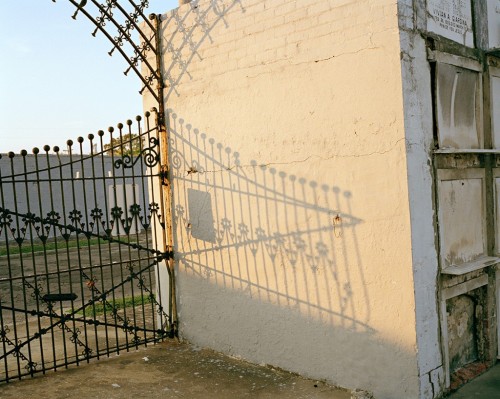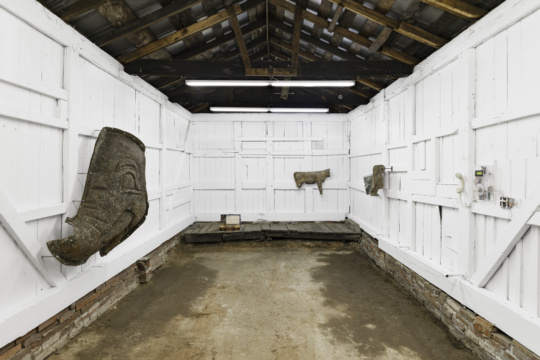
It was a blue-sky day as I was driving along Bayou St. John and City Park toward the library for P.3 Reads, the Prospect Biennial’s version of a book club, one of those October days that remind us New Orleans residents just why we love the city. The surface of the water was perfectly calm, and the sun was a gorgeous yellow, making its way toward the horizon, lighting up the surfaces, turning ordinary facades into beautiful compositions. Fall has finally arrived. The air has lost its stifling blanket of humidity, and yet the sun still warms the skin. We can turn off the A/C and switch from iced coffee to hot.
It’s a perfect setting for the public opening on October 25 of the Prospect.3 biennial. P.3 Reads is one of its outreach programs, a monthly series of conversations held at branch locations of the public library since last January. For each session, P.3 artists choose for discussion a book that has been influential to them. The series reflects P.3 artistic director Franklin Sirmans’s own love of literature while also engaging the local community.
This iteration of P.3 Reads promised to function as a preview of the Prospect.3 exhibition since it was scheduled the week before the opening, and it drew an overflow crowd that filled hastily added seats. The book of the evening was Walker Percy’s 1961 novel, The Moviegoer, discussed by Sirmans and P.3 artist Sophie T. Lvoff. The Moviegoer is set in New Orleans, but among other books associated with the city, it has been overshadowed by A Confederacy of Dunces by John Kennedy Toole. Both were written in the 1960s, though Toole’s was not published until 1980. Both were also award winners, with Toole receiving the Pulitzer Prize for Fiction in 1981 (posthumously) and Percy the National Book Award in 1962 (read about the controversy behind the award that year). Sirmans apparently eyed The Moviegoer on Lvoff’s table during a studio visit then used it as inspiration for the exhibition; he borrows from the book’s vocabulary to explain the exhibition as a whole.
For Lvoff, the book was her way into New Orleans, having first read it when she was living in New York and again after moving to New Orleans, where it inspired her 2010 series of photographs Hell’s Bells/Sulphur/Honey. Lvoff’s photographs give us a New Orleans of quiet spectacle, threaded through books and movies and returned to actual place. The first image was inspired by a description of Carrollton Avenue in The Moviegoer, and the other photographs in the series are all titled after their locations. The images capture a still beauty, the same effect I had noticed that very day while driving down Orleans Avenue.

Yet this beauty is fleeting, its ephemerality a lesson that one learns well upon living in the “everydayness” of New Orleans. Every “magic hour” effect seems offset by the potholes, the corruption, the extreme contrasts of rich and poor. For Binx Bolling, the main character in The Moviegoer, that everydayness was the enemy. Binx is on a “search” to escape the dreaded routine of daily life, and this search is what inspired Sirmans when conceptualizing Prospect.3. The exhibition description begins with Binx’s explanation of the search:
“What is the nature of the search, you ask? Really it is very simple, at least for a fellow like me; so simple that it is easily overlooked. The search is what anyone would undertake if he were not sunk in the everydayness of his own life. To become aware of the search is to be onto something. Not to be onto something is to be in despair.” – Binx Bolling, The Moviegoer
Sirmans called the book a “locating device,” saying that he believed that Prospect must be rooted in its place, New Orleans. This shaped some of his choices, such as including artists who have lived in the city or who engage its sense of place, even if not local. Sirmans was also drawn to the way that Percy’s book is not myopic, that insights about New Orleans are gained by leaving the city and reflecting upon it from afar. The back and forth movement acts as a metaphor for the dynamism of P.3, between its roots in New Orleans and the branches spread all over the world.
While the object of the Binx’s search is never spelled out in the book, Sirmans interprets it as a sense of self, which he roots visually in the work of Gauguin (in particular, the 1897 Where Do We Come From? What Are We? Where Are We Going?, not included in the biennial) and that of Brazilian artist Tarsila do Amaral, whose work is about the search for national identity. For Sirmans, the search raises a series of questions that are at the heart of the exhibition: How do we see each other? How do we see ourselves? The answer: only through each other’s eyes.

This answer might capture the sense of anticipation and anxiety that seems to lace local perception of Prospect. How will the rest of the art world see “us”? Lvoff mentioned Binx’s idea of “certification,” that seeing one’s neighborhood in a movie certifies the place, giving the viewer the feeling that they live “somewhere, not anywhere.” Percy’s phrase was so significant to Sirmans that he used it as the title of his essay in the P.3 catalogue. It is as if New Orleans is not a “somewhere” until it has made it to the big screen, so to speak (P.3 promises much art displayed on screens), allowing “others” to confirm that status. But is it only the Other that has the authority to confer “somewhere” status?
In fact, Lvoff revealed that it was a movie that made her want to move here: Jim Jarmusch’s Down by Law (1986). This was another reason for her to love The Moviegoer, as Binx is an inveterate cinephile and always relates his world to the movies. A tour of New Orleans would not be complete without seeing the locations of the filmic visions of New Orleans: the very balcony that Elvis Presley sang from in King Creole (1958), the house where Anne Rice’s Interview with the Vampire was set (1994), and the LaLaurie House referenced in American Horror Story: Coven (FX, 2013-14). Then there’s the phenomenon of the television series Treme (2010-13), which featured local traditions such as the second line, a kind of neighborhood parade in which the audience becomes participant, following the “first line” of brass band musicians. I had not seen the HBO series when I took a visiting friend to a second line on Claiborne Avenue, and she said that it was “just like Treme.” I had to agree with her once I finally saw the show.

As authentic as Treme might be, it is not real. And yet… fictional visions of New Orleans such as these become part of our reality. The oddness of experiencing our world through the mediation of books and movies may be a postmodern commonplace, but we still don’t fully understand its implications. Deconstructing movies as artifice is too easy a lesson; we can no longer rely on facile distinctions of real/not real, reality/movie. The fabricated image of New Orleans and its use as a signifier of otherness needs deconstructing. Its everydayness needs to be made visible, but it’s not as simple as showing the ugly side of New Orleans. In The Moviegoer. I was struck by Binx’s descriptions of his intentionally boring life in the suburban area known as Gentilly, as opposed to the “old-line” lifestyle (New Orleans-speak for patrician) of his aunt’s house in the Garden District and everything that goes along with it—Mardi Gras krewes and expectations of a professional vocation that would reflect well on the family and contribute to society. It’s the tension between the two lives—in Gentilly and the Garden District—that drives his search.
For Binx, the search was a slippery thing, constantly evading his pursuit, or changing its objective. I think that slipperiness is the best lesson that we can learn from Percy’s book. If Prospect is a search, and Sirmans its Binx Bolling, then we would do well to remember that Binx often forgot about his search. We should not expect a Prospect that settles the score: that deconstructs the cinematic New Orleans and certifies the real one, or neatly summarizes the state of contemporary art today. If it is a search, then let it be an confusing, wandering, wonderful one.
Prospect.3 will be on view October 25, 2014-January 25, 2015 in New Orleans.
Rebecca Lee Reynolds is an assistant professor in the department of fine arts at the University of New Orleans, where she teaches art history.

The Book Behind Prospect.3
Related Stories
Mood Ring
Reviews
Reviews
How To Get Free
Pieced together through collage, video capture, and a spoken poem, artist Kay-Ann Henry presents the intricacies of Afro-religious practices and Jamaica's particular expression of obeah, pocomania, and kumina.
As for me, I’m just passing through this planet at Bad Water, Knoxville
Harrison Wayne reviews the entangled sculptures and taxidermic specimens found in As for me, I’m just passing through this planet at Bad Water, Knoxville.
Everyday Love by Richard Dial at Institute 193, Lexington
Daniel Fuller reviews the crafted metal chairs reflecting tenderness and the human condition in Everyday Love by Richard Dial at Institute 193, Lexington.





